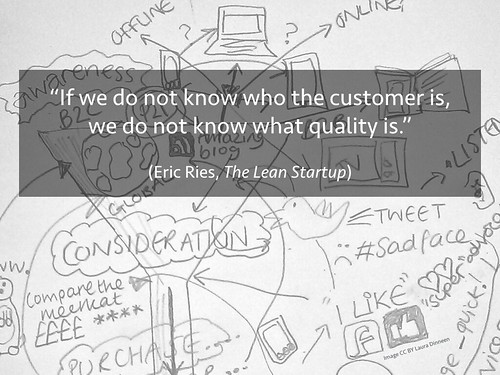
Recently, Eric Ries announced that he was exploring setting up LTSE (Long-Term Stock Exchange), which was first mentioned towards the end of his best-selling book Lean Start-Up. Whilst the original idea was initially pilloried, Ries persisted and has now assembled a team of engineers, finance and legal professionals as well as investors including venture capitalist Marc Andreessen, technology evangelist Tim O’Reilly and former chief technology officer of the United States Aneesh Chopra to explore the idea.
Ries believes that setting up a new long-term focused stock exchange with a different set of rules (voting power weighted towards long-term investors, executive pay tied to long-term performance and disclosure requirements that would allow investors to see how companies are investing) would alleviate much of the short term market and shareholder pressures that are felt by many CEOs of publicly traded companies. In turn, Ries believes that this would allow CEOs and their companies to focus on, foster and invest in innovation.
Whilst this idea is still in its early days and would probably face a lot of opposition, it’s benefits would not be just restricted to innovation.
A recent report from The Storytellers called ‘Two Years’ Warning: The Customer Centricity Crisis’ shows that, like innovation, the quest for customer centricity in publicly quoted companies suffers from the same pressures as innovation.
The report, based on independent, detailed interviews with senior executives and board members from 150 companies in the top 500 of the Forbes 2000, found that:
- 76% of leaders believe that their businesses won’t survive beyond the next two years unless they put more focus on their customers.
- But, 43% of those leaders feel that they have got more important business issues to focus on.
- Moreover, 65% of leaders believe that it’s not up to them to tackle the customer centricity challenge and that it is up to the next generation or the next C-suite to tackle this problem.
In an interview, Co-founder and Director of The Storytellers, Alison Esse comments:
“The tension and conflict seems to come from the fact that C-suites are driven, in the first instance, to deliver for shareholders who expect returns on a very short term basis. Thus, in their eyes, the drive for short-term profitability is not always conducive to delivering a great customer experience. Moreover, customer centricity is seen as more of a longer-term initiative that requires investment and that could have an impact on profitability.”
So, whilst CEOs acknowledge that becoming more customer centric is an existential imperative, efforts to become more customer centric are often displaced by the short-term requirements of the markets, investors and shareholders.
But, despite thinking that the quest for customer centricity should fall at the feet of the next generation of CEOs will the next generation not face the same pressures? They may be better equipped to take on the challenge of customer centricity but unless something changes with respect to market and shareholder pressure there is a risk that they will never transform their companies to becoming more attuned to the needs of their customers.
As a result, unless current and future CEOs are willing to follow the lead of companies like UK companies Unilever , National Grid , G4S and Legal & General and abandon quarterly reporting, many of them may be hoping that Eric Ries and his band of supporters hurry up and establish the LTSE.
This post was originally published on my column on Forbes.com here.
Photo Credit: dougbelshaw via Compfight cc



![[Research Round-Up] New Study Shows the Continuing Value of B2B Thought Leadership](https://customerthink.com/wp-content/uploads/development-2010010_1280-pixabay-innovation-ideas-think-1-218x150.jpg)
Adrian. Brilliant.
We need this to return business to the Customer. Let us hope the LTSE happens
Many CEOs miss the fact that there is no need to choose between customer centricity initiatives and positive short-term and long-term business results. This has been covered in excellent books, such as Firms of Endearment and Conscious Capitalism.
Here’s how I addressed the balance in a blog post from several years ago. “In the book, which was published in 2007, the authors have identified about 30 companies, from multiple industries, that met their criteria. They included CarMax, BMW, Costco, Harley-Davidson, IKEA, JetBlue, Johnson & Johnson, New Balance, Patagonia, Timberland, Trader Joe’s, UPS, Wegmans—and Southwest Airlines. Had the book been written a bit later, it’s likely that Zappos would have made their list as well.
The authors compared financial performance of their selections with the 11 public companies identified by Jim Collins in Good to Great as superior in terms of investor return over an extended period of time. Here’s what they learned:
– Over a 10 year horizon, their selected companies outperformed the Good to Great companies by 1,028 percent to 331 percent (a 3.1 to 1 ratio)
– Over five years, their selected companies outperformed the Good to Great companies by 128 percent to 77 percent (a 1.7 to 1 ratio)
Just on the basis of comparison to the S & P 500, the public companies singled out by Firms of Endearment returned 1,026 percent for investors over the 10 years ending June 30, 2006, compared to 122 percent for the S & P 500, more than an 8 to 1 ratio. Over 5 years, it was even higher—128 percent compared to 13 percent, about a 10 to 1 ratio.”